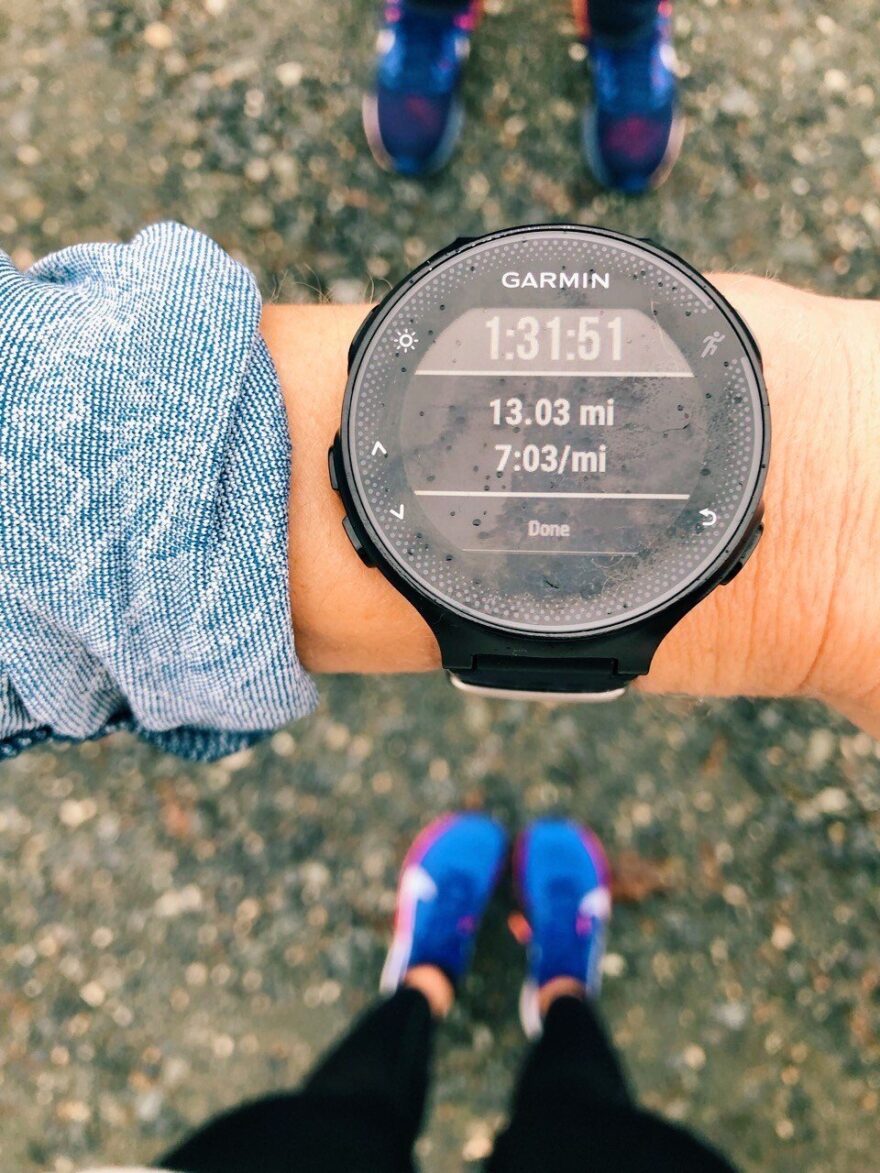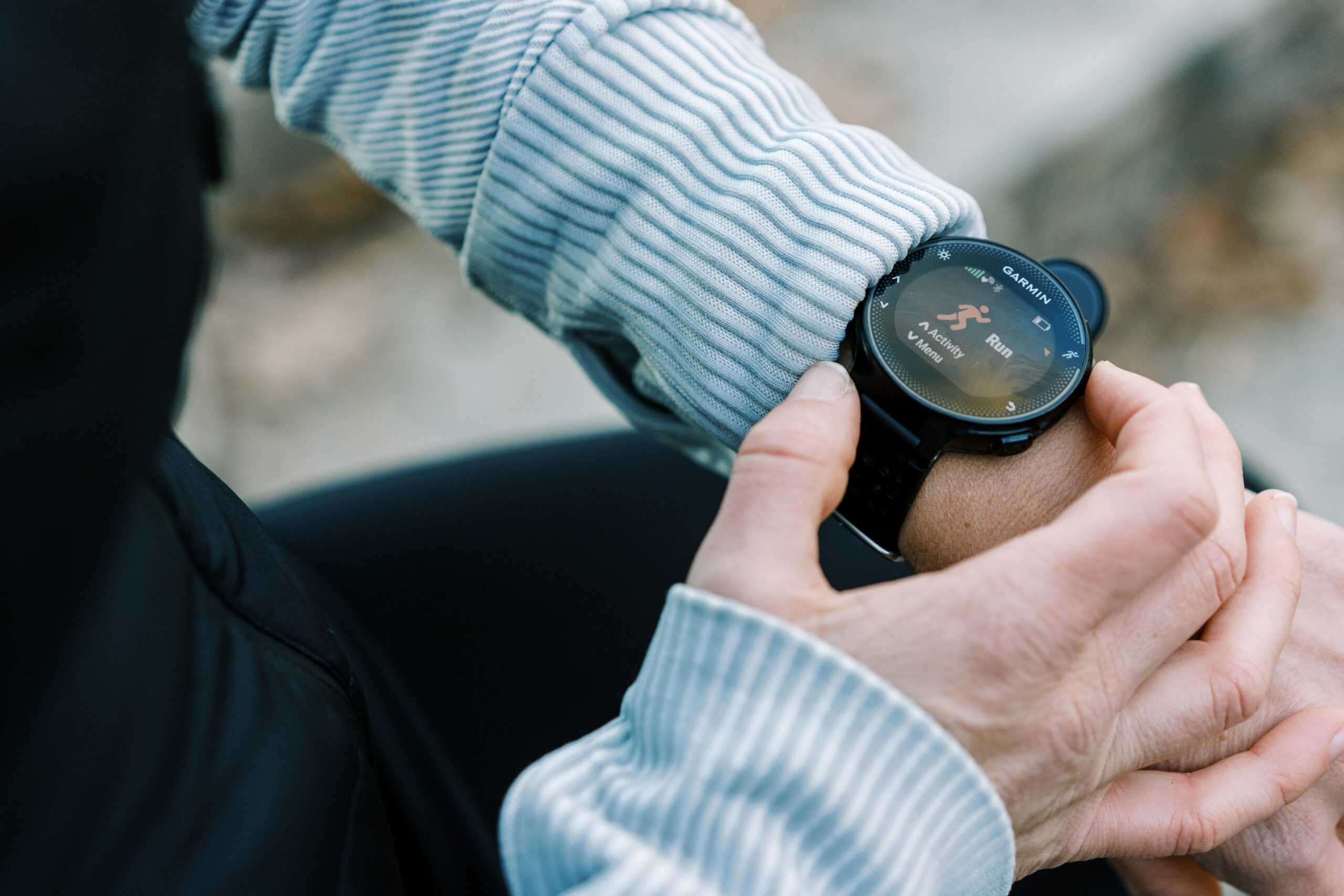


Should you run with a GPS watch? Read these GPS watch pros and cons for running to help you decide!
I’ve got Joanna back for another blog post!
Joanna Thompson is a professional runner for On ZAP Endurance. Originally from Knoxville, Tennessee, she graduated from NC State University in 2015 and moved to Blowing Rock, NC to pursue her professional running dreams. She is an avid reader, an enthusiastic baker, and a self-proclaimed “huge nerd.” Read her 12 tips for beginning distance runners here!
When talking with Joanna a while back, she mentioned she started running with a GPS watch (vs. a plain ol’ timex) pretty recently. I’ve run in a GPS watch for over 15 years and currently run in the Garmin Forerunner 235. Since I’ve been a die-hard Garmin fan for years, I thought it’d be helpful to have Joanna’s insight as a recent covert to a GPS watch.
If you’ve been debating about getting a running watch for yourself for Christmas (or asking a loved one to give you one!), this post will help you decide if it’s the right kind of watch for you and your running. Alright Joanna, take it away!

Not too along ago, I switched from my trusty Timex to a fancy GPS watch. I’ll admit: I was reluctant.
Like a lot of runners, I’m a Type A personality. I fixate on weekly milage or assigned minutes, going as far as to jog in place to make sure I hit the stop button at exactly the right second. It took me forever to chill out and be ok with running 59:47 minutes instead of an hour on the dot. So when one of my coaches suggested I switch to a smartwatch, I was worried it would send me right back to that obsessive mindset.
But here I am, a year or so later, with a new Garmin Forerunner 245 strapped to my wrist. Worth it?
Most runners use a GPS running watch because the features are hard to beat. You’d think running is just lacing up your shoes and hitting the road, but now there are more toys to enjoy. A GPS watch does what you’d expect: tracks the distance, mile splits, calories burned, and some collect even more data so that you get a detailed report of each run. Every GPS watch is different, but in a nutshell, a GPS running watch will track running stats in detail and show it to you in real time.
The #1 reason for me that running with a GPS watch is important is that it allows me to leave my phone at home rather than use my phone to track my run. Plus, watches are engineered to be simple to use while you’re moving. The buttons on the sides are much easier to use than a phone’s touch screen – especially if you’re sweating.
Garmin lets you customize multiple watch faces so you can pick the details you want to see mid-run and the ones you don’t, like pace, cadence, distance, heart rate, etc. Many GPS watches also have the capacity to play downloaded music from Spotify or Apple Music, so your wireless headphones or Airpods pair well.
Most GPS watches are not only fantastic for runners, but also have the capability to track cycling (indoor or out), rowing, walking, and other activities. Beyond tracking workout stats, there are so many features specific to Garmin including Garmin Pay, which is a contactless form of payment, similar to Apple Pay; Garmin Training Plans that can download to your watch; and Garmin Training Load.
Call me old-fashioned, but I like my devices simple. I still carry a first-generation iPod. My computer is a glorified typewriter.
Before I got a smartwatch, the sheer amount of data they collect seemed superfluous to me – I wasn’t going to look at it, so why bother? All I really needed a watch to do was tell time. What’s more, I worried that the deluge of data could tempt me to overanalyze my running. And, to be honest, sometimes it does.
There are days when I experience mild panic if I run my favorite loop a couple minutes slower than normal, and days when I squeeze in a few unnecessary miles at the end of the week to round up my mileage total. So, I do have to keep my sanity in check and not force numbers.
If you’re used to a good ‘ole fashioned stopwatch, a watch charger takes some getting used to. There’s nothing quite like rolling through the fifth rep of a workout only to have your screen suddenly go blank.
I’m pretty bad about remembering to charge things in general, and while most GPS watches will hold a charge for several days, several days isn’t forever. The best solution I’ve found for this particular problem is to use a car charger. That way, I make a habit of juicing up my watch on the way to and from a run/hike/trip to the grocery store. Reviews by other runners say that the Garmin Fenix 6X Pro Solar claims the longest battery life at about 5 days on a single charge. The Garmin Forerunner 235 is around 11 hours per charge, and the Garmin Forerunner 35 holds charge for about 13 hours.
Price is probably the biggest barrier for anyone on the fence about buying a GPS watch. The Forerunner 245 Music will set you back around $300; other watch models can run upwards of $700. And it’s worth noting that most require a smartphone or laptop to connect with, neither of which are exactly cheap.
Luckily, that price is coming down. If you are willing to go with a slightly older model, you can find a reasonable selection for closer to $125.
For as much as I grouch about data overload (kids these days, etc.), having that info is incredibly helpful. For instance, GPS data is great for checking your pace variance, which is important when working to run faster. This is awesome for workouts like fartleks, where each individual mile might stay roughly the same, but the pace within the mile will vary significantly. A Garmin watch will also track your cadence, which can help maximize your stride efficiency in racing.
So what’s the difference between a GPS watch vs. a Fitness Tracker? Fitness trackers use step counters and an accelerometer to track your run, but it’s more of a rough estimate since those don’t use a GPS chip. If you’re looking for something that will help you get faster or run further, I don’t trust these as much. But if you want something to help with activity tracking or something help you reach a step goal, this does the trick just fine.
Most of the smart watches (e.g. an Apple Watch) on the market are now available with GPS tracking and some are even water resistant, but the one thing that sticks out to me is the problem with sweat and a touch screen. Those watches are made for daily use, and most of the time they work perfectly for our needs, but when you’re really sweaty, you’ll wish you had a few buttons to press to make the watch do what you want. Again, it’s not a huge deal for casual runs, but something to consider. GPS running watches are designed specifically for sports, so they’ve been engineered to work in conditions like sweaty, rain, extreme heat, etc. and they’re easier to use mid-run vs. a touchscreen.
Sleep is the single most important recovery tool at your disposal. Getting enough sleep (read: roughly 8 hours a night) can help stave off injury, decrease stress hormones, and lower anxiety. Despite knowing this, I used to be terrible at sleeping; I have no excuse except college.
My watch’s sleep tracking feature is, honestly, kind of a lifesaver. Unlike mileage, you can’t overdo sleep, so getting competitive with your z’s is great for training. Many watch models, including mine, even diagram your sleep stages every night, so you know how much deep sleep vs. light sleep vs. REM you’ve had.
From resting to running to watching a scary movie with your significant other, your heart rate fluctuates considerably every day. These fluctuations can provide some key insights into your fitness. If, for example, you spend most of an easy run in your max heart rate zone, there is a good chance you’re overtraining. Luckily, heart rate tracking is a feature of most GPS watches.
Having a built-in heart rate monitor strapped to your wrist makes tracking your beats per minute a no-brainer. I used to keep a little clip-on heart rate monitor from Walmart next to my bed so I could take my resting heart rate every morning and enter it into an excel spreadsheet for my coach. I think I maybe remembered to do this three times, tops. Now, my watch does the hard work for me, and I can make sure that my recovery days are truly recovery.
Hands down, my Garmin’s Stopwatch gets more use than any other feature. Why? Because I’m a mess and a grump and I don’t want to be tempted to run too fast on easy days.
BUT.
Having the GPS available is awesome. The beauty of the GPS smartwatch is that you don’t have to use all the bells and whistles all the time. I’m still perfectly free to turn off the tracking and just go for a run. Which, truly, is what I was afraid I’d lose in the upgrade.
As long as you can afford one, having a smartwatch is a great training tool. But like all training tools, it’s important to use it to your best advantage. If numbers send you into panic mode, turn off the GPS tracking; if data makes you feel more comfortable, take advantage of all the measurements. Really, the best part about using a smartwatch is having options. I was reluctant at first, but I have to admit, I’ve fallen in love with mine. Oh, and did I mention that it holds music? Because it totally holds music, so you can sync it with your own favorite tunes or Teri’s favorite running playlists.

Want more running tips and gear recommendations sent right to your inbox? Sign up for Teri’s running newsletter here!


Leave a Comment
4 responses to “Pros and Cons of Running with a GPS Watch”
I love my GPS watch for outdoor runs, but it drives me insane on the treadmill! I try not to freak out when the numbers don’t match…I’m a work in progress 🙂
When I wear my Garmin for treadmill runs, it NEVER matches what the treadmill says! I defer to the treadmill mileage for indoor runs!
I don’t run, but this sleep tracking feature on the GPS watch is interesting. Must look into it further.
A GPS watch coming from a popular brand is around 400 USD on Amazon. Solar charging is an advantage there. Most of this price range GPS works fine in rain and on middle-of-nowhere hikes.